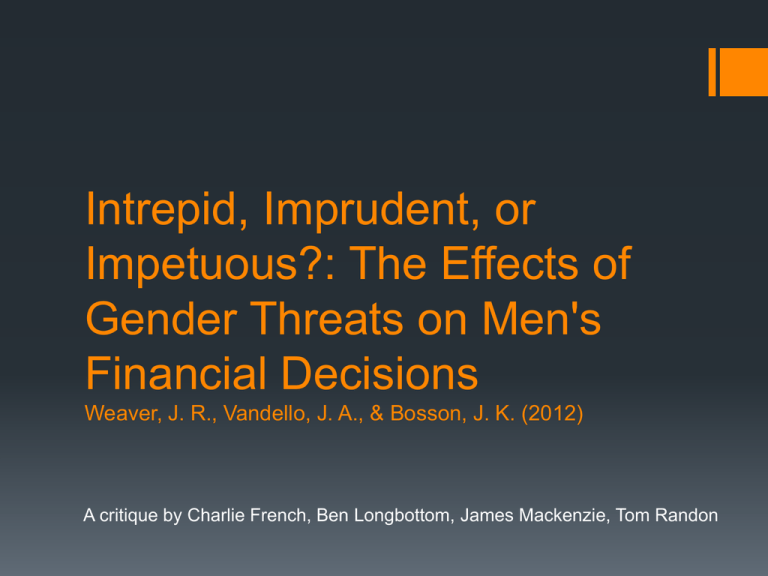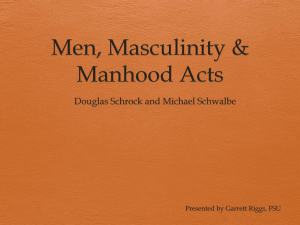
Intrepid, Imprudent, or
Impetuous?: The Effects of
Gender Threats on Men's
Financial Decisions
Weaver, J. R., Vandello, J. A., & Bosson, J. K. (2012)
A critique by Charlie French, Ben Longbottom, James Mackenzie, Tom Randon
The Financial Crisis of 2007-08
A multitude of contributing factors have been suggested,
including risk
A major cause was subprime lending, which included huge
risks
1. Market doing well, subprime lending occurred
2. Subprime loans were collateralised with higher rated debt
(collateralised debt obligations – CDOs)
3. Packaged CDO loans sold to other banks
4. House prices fell, causing bank liabilities to increase
5. Fall of market caused trading reluctances from banks
6. Government stepped in
Background to the study
Risk’s role in the financial crisis and who took these risks
Wall Street’s hyper-masculine culture (Martin, 2009)
Testosterone levels have been linked with risk (Coates &
Herbert, 2008)
Men are less risk averse than women (Jianakoplos &
Bernasek, 1998)
Men take more risks and discount future rewards in malemale environments (Griskevicius et al., 2012)
Overview
Investigated the role of masculinity in the financial crisis
Two experiments focused on challenging male masculinity
and how they reacted in financial decision situations
Both experiments found significant effects
First experiment explored the prediction that risk taking becomes
more attractive under the threat of manhood (Prentice &
Carranza, 2002)
Second experiment explored the prediction that men seek
imminent rewards to prevent anxiety from manhood threats
(Vandello et al., 2008)
Experiment 1
Experiment served as a test of two competing hypotheses
Hypothesis 1: Men who perform the gender threat condition
will take greater financial risks (i.e. place higher bets), as a
way of compensation
Hypothesis 2: Gender affirmation men might take greater
risks as they may have assimilation effects
38 students, all heterosexual males
Two groups:
Group 1: Gender Threatening – testing a fruit scented hand lotion
in a pink bottle.
Group 2: Gender affirmation task - testing a power drill
Experiment 1 Method
The participants then played a gambling game, with a die
and had to bet on whether it would show an odd or even
number. (2/1 odds)
Game was repeated 5 times
All given $5. Could place bets of $0, $0.25, $0.5, $0.75 or $1
The experiment was videoed to give an audience effect
Experiment 1 Results
Average bet
Average no. of max bets
Experiment 1 Results
They found evidence to support hypothesis 1
Men whose gender was threatened (hand lotion) placed
higher bets in each individual round compared to the men
whose gender was affirmed (power drill)
29% more money as an average
The threat manipulation had its strongest effects on earlier
bets and was attenuated by the last bet
Hypothesis 2 was rejected
Experiment 1 Critique
Insufficient sample size and demographic
No true control
No female comparison offered, so gender threats might not
just apply to men
Women in positions of power take as many risks as men
(Johnson & Powell, 1994)
Between subjects design
Individual differences in risk taking
Experiment 1 Critique
Audience simulation via a video camera
The study is a simulation and does not consider real life data.
Wong & Caducci (1991) tested real life examples, hence possibly
conducting a study of greater validity?
Gambling risk results vs. day-to-day risk results in reaffirming
masculinity
Shortfalls in the generalization of findings
Experiment 2
Examined the effect of gender threats on men’s motivation to
seek immediate over delayed rewards, and whether this
motivation is increased when in a public context.
The final sample consisted of 73 heterosexual men.
The age of the participants ranged from 18 to 43 years old.
(median = 20).
The design was a 2 x 2 between subjects design.
Experiment 2 Method
To manipulate gender threat, men were asked to recall either
10 specific behaviours (gender threat condition) or 2 specific
behaviours (gender affirmation condition) from the past
month that demonstrated them as a “real man”.
This was an adaptation of a procedure developed by Schwarz et
al. (1991).
Experiment 2 Method
In the second half of the experiment, participants completed
a financial decision questionnaire.
7 items to measure participants’ preference for immediate,
smaller financial payoffs versus delayed, but larger financial payoffs.
Smaller sum of money tomorrow, or a larger sum of money in 90
days.
Modified from Griskevicius, Tybur, Delton, and Robertson (2011).
Half of the participants were told they would be videotaped
after the questionnaire and have to explain their choices.
Other half thought that no one would see their responses.
Experiment 2 Results
Men who listed 10 “real man” behaviors (M = 6.36, SD =
2.17) rated the listing task as more difficult than men who
listed two “real man” behaviors (M = 4.35, SD = 2.28), F(1,
71) = 14.92, p < .001, d = .90.
In addition, men who listed 10 behaviors reported feeling
significantly less masculine (M = 6.42, SD = 1.54) compared
to men who listed two behaviors (M = 7.01, SD = 0.88), F(1,
71) = 4.10, p = .047, d = .47.
Experiment 2 Results
ted by the American Psychological Association or one of its allied publishers.
for the personal use of the individual user and is not to be disseminated broadly.
GENDER THREATS AND MEN’S FINANCIAL DECISIONS
18
Figure 3b. Average dollar amount forfeited as a function of gender threat and audience (Experiment 2). Error
bars represent standard errors of the mean.
placed higher bets following the product testing of a power drill. In
fact, we found the opposite—men who tested a feminine hand
lotion became more risky. The results also cannot be explained
simply as a contrast effect in automatic behavior (Dijksterhuis et
al., 1998). Contrast effects tend to occur following priming of
specific exemplars (e.g., Albert Einstein before a test) that evoke
social comparison. Neither of our experiments involved manipulations where participants could make social comparisons. Therefore, it is likely that the effects are driven by the anxiety produced
by threatened manhood. However, it would be interesting to see if
priming gender-threatened men with an exemplar (e.g., a “manly
man” like Chuck Norris) would decrease their risk taking.
Together, the experiments presented here suggest a sensitivity to
manhood threats that motivates a mindset of impetuous, presentfocused financial risk-taking. We note, of course, that risk-taking
Riley & Chow, 1992; Zinkhan & Karande, 1991). However, wh
may be equally or more important in driving these gender diffe
ences is the competitive masculine culture of the financial worl
that motivates male risk-taking and future discounting in genera
and more specifically, as a means of coping with manhood threat
Along similar lines the current two experiments did not examin
women and gender-threats. Past work has shown that womanhood
as compared to manhood, is not seen as a precarious state that mu
be continually proved. In addition, gender-threatening feedbac
arouses stronger feelings of anxiety, threat, and shame among me
than among women (Vandello et al., 2008). That is not to say th
a woman cannot be seen as a “bad” woman or “unladylike,” bu
that her status as a woman is not as easily threatened or called int
question by others. Thus, womanhood is not fraught with the sam
precariousness that manhood is. It is possible that gender statu
Experiment 2 Critique
Better sample size and choice of experimental design.
Insufficient demographic (median age = 20).
University student sample unlikely to be an accurate
representation of a population.
General Critique
States it is only investigating the causes of the US
financial crisis but the financial crisis was worldwide.
Ethnic background of participants taken into account
but not financial background.
Experiment 1
Age range = 18 to 40, median age = 19
Experiment 2
Age range = 18 to 43, median age = 20
Deery (1999)- young people more likely to underestimate
risk.
Differences between the two experiments
methods.
General Critique continued…
Wording used by experimenters.
The study has low ecological validity.
Although the principal has validity and the rationale
is backed up well with literature, is it really
relevant?
Lack of control groups.
No female participants.
References Critique
56 total references.
Year that references where published range from 1972 to
2012.
28 references where published in the 2000’s and 21 in the
1990’s.
Journal with most references is Journal of Personality and
Social Psychology.
Not only Psychological journals used.
On occasions, the authors make statements
without using references to back them up, e.g. “the
crisis was at least partially caused by a series of illadvised gambles” and “When their manhood status
is perceived to be threatened, men become
motivated to take restorative actions.”
Authors sometimes use multiple references to
back up statements, which is good, but do not
explain studies referenced.
Evidence to support the study
Manhood requires continual proof (Bosson & Vandello, 2011)
Evolutionary view towards threatening manhood (Wilson &
Daly, 2005)
People in high positions of power have lower EQ (Galinsky,
Gruenfeld & Magee, 2003)
‘The London Whale’ case study
Evidence opposing the study
Higher cortisol levels cause an increase in risk taking (van
den Bos, 2009)
Tenuous links to the financial crisis
Incorrect pricing of risk in the run up to the financial crisis
(Simkovic, 2009)
When did the ‘threatening of manhood’ occur?
Banks became more risk averse when they ran into trouble
Trading works both ways, where there in someone losing,
someone is benefitting
Future research and implications
of the study
This study shows that manhood can be threatened and
bigger risks will be taken when manhood is threatened.
Fewer men in the same workplace.
May want to carry out the study including women.
Scope for exploring the genetic basis of risk takers.(Dreber et
al, 2009)
References
Baron-Cohen, S., & Wheelwright, S. (2004). The empathy quotient: an investigation of
adults with Asperger syndrome or high functioning autism, and normal sex differences.
Journal of Autism and Developmental Disorders, 34(2), 163-75.
Bosson, J. K., & Vandello, J. A. (2011). Precarious manhood and its links to action and
aggression. Current Directions in Psychological Science, 20, 82–86.
Coates, J. M., & Herbert, J. (2008). Endogenous steroids and financial risk taking on a
London trading floor. PNAS Proceedings of the National Academy of Sciences of the
United States of America, 105, 6167–6172.
Deery, H. (1999). Hazard and Risk Perception among Young Novice Drivers. Journal of
Safety Research, 30 (4), 225-236.
Dreber, A., Apicella, C. L., Eisenberg, D. T., Garcia, J. R., Zamore, R. S., Lum, J. K., &
Campbell, B. (2009). The 7R polymorphism in the dopamine receptor D4 gene (DRD4)
is associated with financial risk taking in men. Evolution and Human Behavior, 30(2),
85-92.
Galinsky, A. D., Gruenfeld, D. H., Magee, J. C. (2003). Journal of Personality and Social
Psychology, 85(3), 453-466.
Griskevicius, V., Tybur, J. M., Ackerman, J. M., Delton, A. W., Robertson, T. E., & White,
A. E. (2012). The financial consequences of too many men: Sex ratio effects on saving,
borrowing, and spending. Journal of Personality and Social Psychology, 102, 69–80.
Jianakoplos, N. A., & Bernasek, A. (1998). Are women more risk averse? Economic
Inquiry, 36, 620–630.
Johnson, J. E., & Powell, P. L. (1994). Decision making, risk and gender: are managers
different? British Journal of Management, 5(2), 123-138.
Martin, C. E. (2009, June 27). Was the economic meltdown a crisis of masculinity run
amuck? It’s time for women to step in. Alternet. Retrieved November 26, 2013, from
http://www.alternet.org/
References
NCRW (2009). Women in fund management: A road map for achieving critical mass–
And why it matters. New York: NCRW.
Prentice, D. A., & Carranza, E. (2002). What women should be, shouldn’t be, are
allowed to be, and don’t have to be: The contents of prescriptive gender stereotypes.
Psychology of Women Quarterly, 26, 269–281.
Simkovic, M. (2009). Secret Liens and the Financial Crisis of 2008. American
Bankruptcy Law Journal, 83, 253.
van den Bos, R., Harteveld, M., & Stoop, H. (2009). Stress and decision making in
humans: Performance is related to cortisol reactivity, albeit differently in men and
women. Psychoneuroendocrinology, 34, 1449-1458.
Vandello, J. A., Bosson, J. K., Cohen, D., Burnaford, R. M., & Weaver, J. R. (2008).
Precarious manhood. Journal of Personality and Social Psychology, 95, 1325–1339.
Wilson, M., & Daly, M. (2005). Carpe diem: Adaptation and devaluing the future.
Quarterly Review of Biology, 80, 55–60.
Wolf, W. C., & Fligstein, N. D. (1979). Sex and authority in the workplace: The causes of
sexual inequality. American Sociological Review, 44(2), 235-252.
Wong, A., & Carducci, B. J. (1991). Sensation seeking and financial risk taking in
everyday money matters. Journal of Business and Psychology, 5(4), 525-530.












